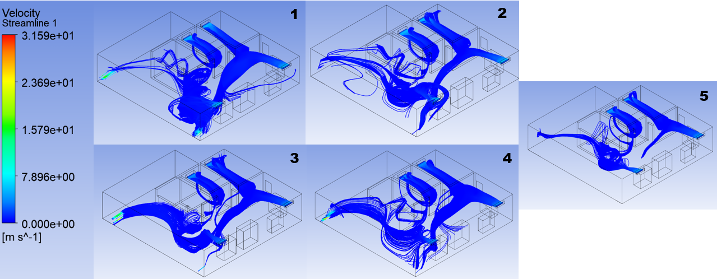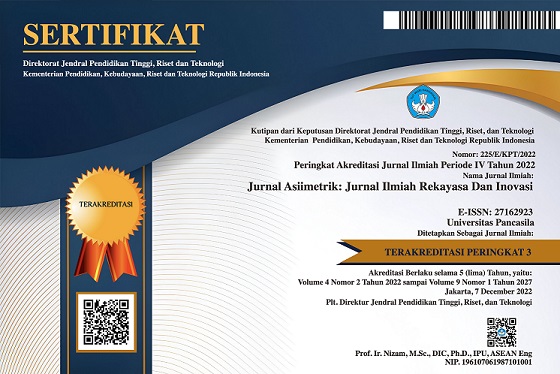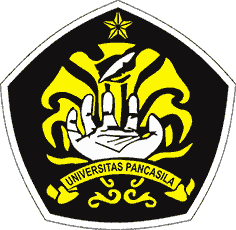Analisis Aliran Udara dan Kenyamanan Termal di Laboratorium Perpindahan Panas dan Massa menggunakan Metode Computational Fluid Dynamics (CFD)
Air circulation and Thermal Comfort Analysis of Heat & Mass Transfer Laboratory Using Computational Fluid Dynamics (CFD) Method
DOI:
https://doi.org/10.35814/asiimetrik.v5i1.3122Keywords:
CFD, thermal comfort, airflow, COVID-19Abstract
Air circulation and thermal comfort are some of many factors that affects user’s behavior in indoor activity, particularly in learning activity. With appropriate air quality and thermal comfort, it is easier for students to focus on the learning process. In addition, better air circulation can also benefit to the health of the people inside the building, for instance, according to WHO (World Health Organization), appropriate airflow may reduce the spread of SARS-CoV-2 which lately has caused a COVID-19 pandemic. However, air circulation and distribution have not a concern yet due to existing room condition and advanced technology that is needed, in L 609 classroom and Heat & Mass Transfer Laboratory, in this research. CFD method implementation for this case is used to show existing air circulation condition and necessary recommendations to get better air circulation. CFD simulation is done 3 dimensionally with 44344 nodes tetrahedral mesh on 2 configuration room condition, which are classified based on air input from AC, door gap, and with or without window opening. Based on CFD simulation results, the 2nd configuration with window opening indicate the best configuration with air velocity around 0,8 m/s dan room temperature 295,8 – 302,1 K. With window opening, the air flow condition met the ANSI/ASHRAE 55 and hoped to reduce COVID-19 spreading.
Downloads
References
ASHARE (2021) Standard 55 – Thermal Environmental Conditions for Human Occupancy. Canada: ASHARE [Cetak].
Chen, C.-Y. dkk. (2021) ‘Recommendations for ventilation of indoor spaces to reduce COVID-19 transmission’, Journal of the Formosan Medical Association, 120(12), hal. 2055–2060.
CNN (2020) ‘Data Temukan Gejala Covid-19 Paling Umum, Bukan Batuk Kering’, CNN Indonesia. Available at: https://www.cnnindonesia.com/gaya-hidup/20201126090119-255-574641/data-temukan-gejala-covid-19-paling-umum-bukan-batuk-kering [Online] (Diakses: 11 Desember 2020).
Conrad, K. dan Lynnworth, L. (2002) ‘Fundamental of Ultrasonic Flow Meters’, in Proceedings American School of Gas Measurement Technology. American School of Gas Measurement Technology - ASGMT, USA: American School of Gas Measurement Technology.
Darmawan, S. (2020) ‘Reynolds number effects on swirling flows intensity and reattachment length over a backward-facing step geometry using STD k-ε turbulence model’, in IOP Conference Series: Materials Science and Engineering. 2nd TICATE 2019, Jakarta: IOP Publishing, hal. 012073.1-012073.9.
Darmawan, S. dan Tanujaya, H. (2019) ‘CFD Investigation of Flow Over a Backward-facing Step using an RNG k-? Turbulence Model’, IJTech - International Journal of Technology, 10(2), hal. 280–289.
Gratia, E., Bruyere, I. dan De Herde, A. (2004) ‘How to use natural ventilation to cool narrow office buildings’, Building and environment, 39(10), hal. 1157–1170.
Kundu, P., Cohen, I. dan Dowling, D. (2015) Fluid Mechanics - 6th Edition. 6th edn. USA: Academic Press - Elsavier [Cetak].
Liping, W. dan Hien, W.N. (2007) ‘Applying natural ventilation for thermal comfort in residential buildings in Singapore’, Architectural Science Review, 50(3), hal. 224–233.
Morawska, L. dkk. (2020) ‘How can airborne transmission of COVID-19 indoors be minimised?’, Environment International, 142, hal. 105832.1-105832.7.
Rønneseth, Ø. dkk. (2019) ‘Techniques for airflow measurements to determine the real efficiency of heat recovery in ventilation systems’, in IOP Conference Series: Earth and Environmental Science. 1st Nordic conference on Zero Emission and Plus Energy Buildings, Belgium: IOP Publishing, hal. 012068.1-012068.8.
Sari, S.P., Saputra, D.K. dan Donawan (2019) ‘Analisis Energi Listrik Dari Panas Kondensor Air Conditioner dengan Insulasi dan Generator Termoelektrik’, Jurnal Asiimetrik: Jurnal Ilmiah Rekayasa & Inovasi, 1(2), hal. 65–72.
Tanujaya, H. dan Darmawan, S. (2021) ‘Investigation of Flow of the Disc-and-Doughnut Baffles and 40% Cut Segmental Baffles’, International Journal of Heat and Technology, 39(5), hal. 1541–1548.
WHO (2020) Question and Answers on COVID-19. Available at: https://www.who.int/emergencies/diseases/novel-coronavirus-2019/question-and-answers-hub [Online] (Diakses: 12 November 2020).





























